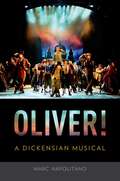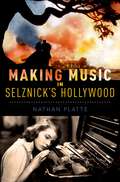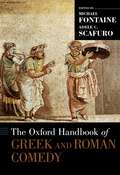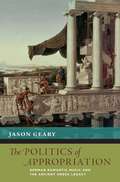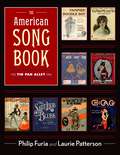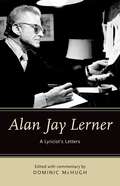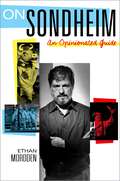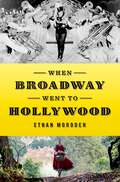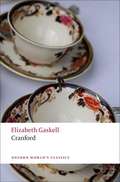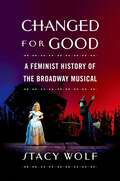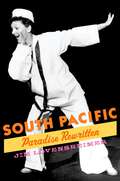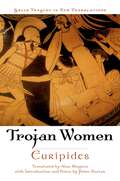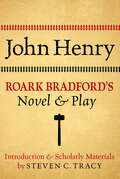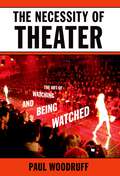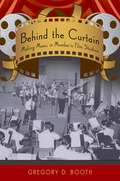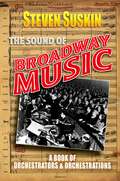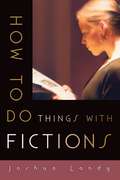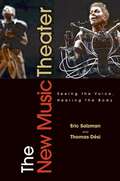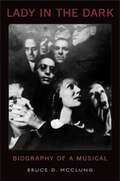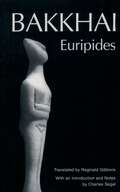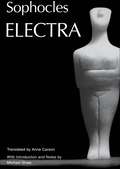- Table View
- List View
Oliver!: A Dickensian Musical
by Marc NapolitanoWhen the show was first produced in 1960, at a time when transatlantic musical theatre was dominated by American productions, Oliver! already stood out for its overt Englishness. But in writing Oliver!, librettist and composer Lionel Bart had to reconcile the Englishness of his Dickensian source with the American qualities of the integrated book musical. To do so, he turned to the musical traditions that had defined his upbringing: English music hall, Cockney street singing, and East End Yiddish theatre. This book reconstructs the complicated biography of Bart's play, from its early inception as a pop musical inspired by a marketable image, through its evolution into a sincere Dickensian adaptation that would push English musical theatre to new dramatic heights. The book also addresses Oliver!'s phenomenal reception in its homeland, where audiences responded to the musical's Englishness with a nationalistic fervor. The musical, which has more than fulfilled its promise as one of the most popular English musicals of all time, remains one of the country's most significant shows. Author Marc Napolitano shows how Oliver!'s popularity has ultimately exerted a significant influence on two separate cultural trends. Firstly, Bart's adaptation forever impacted the culture text of Dickens's Oliver Twist; to this day, the general perception of the story and the innumerable allusions to the novel in popular media are colored heavily by the sights, scenes, sounds, and songs from the musical, and virtually every major adaptation of from the 1970s on has responded to Bart's work in some way. Secondly, Oliver! helped to move the English musical forward by establishing a post-war English musical tradition that would eventually pave the way for the global dominance of the West End musical in the 1980s. As such, Napolitano's book promises to be an important book for students and scholars in musical theatre studies as well as to general readers interested in the megamusical.
Making Music in Selznick's Hollywood (Oxford Music/Media Series)
by Nathan PlatteThrough the rise and fall of the Hollywood studio system, David O. Selznick reigned as Hollywood's preeminent producer. His reputation depended in large part on music. The orchestral cacophony of King Kong, the pulsing electronic sonorities of Spellbound, and the Tara theme from Gone with the Wind made music a distinguishing feature of the Selznick experience. By flaunting music's role in film and overseeing its distribution through sheet music, concerts, radio broadcasts, and soundtrack albums, Selznick cultivated a fascination with film scores. But he did not do it alone. In Making Music in Selznick's Hollywood, Nathan Platte brings to light the men and women whose work sounds throughout Selznick's many films. The cast includes familiar composers like Max Steiner, Franz Waxman, and Dimitri Tiomkin, but extends to overlooked contributors, including music editor Audray Granville, orchestrator Hugo Friedhofer, harpist Louise Klos, choral director Jester Hairston, publicist Ted Wick, and many others. Novelists, studio writers, and directors like Alfred Hitchcock also influenced the soundscapes of Selznick's films. Whether working with the producer directly or managing his presence from a distance, all had to reckon with Selznick's musical preoccupations. Rarely was it easy. Rewritten scores, fired personnel, and other skirmishes reflect the troubles-and uneven compromises-that shaped music for films like Gone with the Wind, Duel in the Sun, and Rebecca. Even Selznick anticipated that such problems would "go down in the history of Hollywood as the last wild fling of people who really fiddled-and how!-while Hollywood burned." Drawing on extensive archival research, Platte recounts those stories here, tracing Selznick's musical labors during the silent era through his work at the major studios and his culminating efforts at Selznick International Pictures. Taken together, Selznick's films provide a sweeping vista of the relationships among musicians and filmmakers that defined the Hollywood sound.
The Oxford Handbook of Greek and Roman Comedy (Oxford Handbooks)
by Michael Fontaine Adele C. ScafuroIn recent decades literary approaches to drama have multiplied: new historical, intertextual, political, performative and metatheatrical, socio-linguistic, gender-driven, transgenre-driven. New information has been amassed, sometimes by re-examination of extant literary texts and material artifacts, at other times from new discoveries from the fields of archaeology, epigraphy, art history, and literary studies. The Oxford Handbook of Greek and Roman Comedy marks the first comprehensive introduction to and reference work for the unified study of ancient comedy. From the birth of comedy in Greece to its end in Rome, from the Hellenistic diffusion of performances after the death of Menander to its artistic, scholarly, and literary receptions in the later Roman Empire, no topic is neglected. 41 essays spread across Greek Comedy, Roman Comedy, and the transmission and reception of Ancient comedy by an international team of experts offer cutting-edge guides through the immense terrain of the field, while an expert introduction surveys the major trends and shifts in scholarly study of comedy from the 1960s to today. The Handbook includes two detailed appendices that provide invaluable research tools for both scholars and students. The result offers Hellenists an excellent overview of the earliest reception and creative reuse of Greek New Comedy, Latinists a broad perspective of the evolution of Roman Comedy, and scholars and students of classics an excellent resource and tipping point for future interdisciplinary research.
The American Song Book: The Tin Pan Alley Era
by Philip Furia Laurie J. PattersonThe American Song Book, Volume I: The Tin Pan Alley Era is the first in a projected five-volume series of books that will reprint original sheet music, including covers, of songs that constitute the enduring standards of Irving Berlin, Jerome Kern, the Gershwins, and other lyricists and composers of what has been called the "Golden Age" of American popular music. These songs have done what popular songs are not supposed to do-stayed popular. They have been reinterpreted year after year, generation after generation, by jazz artists such as Charlie Parker and Art Tatum, Ella Fitzgerald and Louis Armstrong. In the 1950s, Frank Sinatra began recording albums of these standards and was soon followed by such singers as Tony Bennet, Doris Day, Willie Nelson, and Linda Ronstadt. In more recent years, these songs have been reinterpreted by Rod Stewart, Harry Connick, Jr., Carly Simon, Lady GaGa, K.D. Laing, Paul McCartney, and, most recently, Bob Dylan. As such, these songs constitute the closest thing America has to a repertory of enduring classical music. In addition to reprinting the sheet music for these classic songs, authors Philip Furia and Laurie Patterson place these songs in historical context with essays about the sheet-music publishing industry known as Tin Pan Alley, the emergence of American musical comedy on Broadway, and the "talkie" revolution that made possible the Hollywood musical. The authors also provide biographical sketches of songwriters, performers, and impresarios such as Florenz Ziegfeld. In addition, they analyze the lyrical and musical artistry of each song and relate anecdotes, sometimes amusing, sometimes poignant, about how the songs were created. The American Songbook is a book that can be read for enjoyment on its own or be propped on the piano to be played and sung.
Alan Jay Lerner: A Lyricist's Letters
by Dominic MchughThe man behind "I Could Have Danced all Night" and "Almost Like Being in Love", lyricist Alan Jay Lerner (1918-1986) is widely regarded as one of the most important figures of the American musical stage. In penning the lyrics to some of the most well-known and beloved Broadway shows, including Brigadoon, Paint Your Wagon, My Fair Lady, and Camelot, Lerner worked and corresponded with some of the greatest luminaries of popular entertainment over a career which spanned four decades, from performers like Rex Harrison and Julie Andrews to composers like André Previn, Leonard Bernstein, Charles Strouse, Andrew Lloyd Webber, and especially Frederick Loewe. In this rich collection of correspondence, most of it published for the first time, author Dominic McHugh sheds new light on Lerner's working relationships with these legendary figures. McHugh's extensive commentary reveals Lerner's turbulent partnerships with Loewe and Lane, his affection for Harrison, and his reverence for Burton. Particular emphasis is placed on Lerner's aborted projects with composers like Richard Rodgers and Arthur Schwartz. Especially valuable is the correspondence from his final years, in which he worked on a movie version of The Merry Widow, a BBC TV series about musicals, and a musical version of My Man Godfrey, none of which came to fruition. The collection ends with a poignant final exchange between Lerner and Andrew Lloyd Webber, with whom he was to have written The Phantom of the Opera. Overall, this important and lively book reveals the highs and lows of the career of one of America's wittiest and most romantic lyricists.
On Sondheim: An Opinionated Guide
by Ethan MorddenIn On Sondheim, renowned author Ethan Mordden takes the reader on a tour of Stephen Sondheim's work, arguing for the importance and appeal of the composer-lyricist in American theater and, even more, in American culture. Over the course of eighteen shows, Mordden demonstrates that Sondheim is a classical composer who happens to write musicals. Sondheim has intellectualized the musical by tackling serious content usually reserved for the spoken stage: nonconformism (in Anyone Can Whistle, 1964), history (in Pacific Overtures, 1976), and cannibalism as a metaphor for class warfare (Sweeney Todd, 1979). Yet his work combines complex music and intellectual plots with a masterly skill for the fabric of theatre. His shows are all intensely theatrical, produced with flair and brilliance, whether in the lush operetta of A Little Night Music (1973) or the quixotic fairy-tale magic of Into the Woods (1987). Mordden provides fresh insights and analyses of every Sondheim show, from his first hit (West Side Story, 1957) to his most recent title (Road Show, 2008). Each musical has a dedicated chapter, including articles on Sondheim's life and his major influences, and comprehensive bibliographical and discographical essays place the Sondheim literature and recordings in perspective. Writing with his usual blend of the scholarly and the popular - with a wicked sense of humor - Ethan Mordden reveals why Stephen Sondheim has become Broadway's most significant voice in the last fifty years.
On Sondheim: An Opinionated Guide
by Ethan MorddenIn On Sondheim, renowned author Ethan Mordden takes the reader on a tour of Stephen Sondheim's work, arguing for the importance and appeal of the composer-lyricist in American theater and, even more, in American culture. Over the course of eighteen shows, Mordden demonstrates that Sondheim is a classical composer who happens to write musicals. Sondheim has intellectualized the musical by tackling serious content usually reserved for the spoken stage: nonconformism (in Anyone Can Whistle, 1964), history (in Pacific Overtures, 1976), and cannibalism as a metaphor for class warfare (Sweeney Todd, 1979). Yet his work combines complex music and intellectual plots with a masterly skill for the fabric of theatre. His shows are all intensely theatrical, produced with flair and brilliance, whether in the lush operetta of A Little Night Music (1973) or the quixotic fairy-tale magic of Into the Woods (1987). Mordden provides fresh insights and analyses of every Sondheim show, from his first hit (West Side Story, 1957) to his most recent title (Road Show, 2008). Each musical has a dedicated chapter, including articles on Sondheim's life and his major influences, and comprehensive bibliographical and discographical essays place the Sondheim literature and recordings in perspective. Writing with his usual blend of the scholarly and the popular - with a wicked sense of humor - Ethan Mordden reveals why Stephen Sondheim has become Broadway's most significant voice in the last fifty years.
When Broadway Went to Hollywood
by Ethan MorddenWhen films like The Jazz Singer started to integrate synchronized music, in the late 1920s many ambitious songwriting pioneers of the Great White Way - George and Ira Gershwin, Cole Porter, Richard Rodgers, and Lorenz Hart, among many others - were enticed westward by Hollywood studios' promises of national exposure and top dollar success. But what happened when writers native to the business of Broadway ran into the very different business of Hollywood? Their movies had their producer despots, their stacking of writing teams on a single project, their use of five or six songs per story where Broadway fit in a dozen, and it seemed as if everyone in Hollywood was uncomfortable with characters bursting into song on the street, in your living room, or in "a cottage small by a waterfall." Did the movies give theater writers a chance to expand their art, or did mass marketing ruin the musical's quintessential charm? Is it possible to trace the history of the musical through both stage and screen manifestations, or did Broadway and Hollywood give rise to two wholly irreconcilable art forms? And, finally, did any New York writer or writing team create a film musical as enthralling and timeless as their work for the stage? In When Broadway Went to Hollywood, writer and celebrated steward of musical theatre Ethan Mordden directs his unmistakable wit and whimsy to these challenging questions and more, charting the volatile and galvanizing influence of Broadway on Hollywood (and vice versa) throughout the twentieth century. Along the way, he takes us behind the scenes of the great Hollywood musicals you've seen and loved (The Wizard of Oz, Gigi, The Sound of Music, Chicago, West Side Story, The Music Man, Grease) as well as some of the outrageous flops you probably haven't. The first book to tell the story of how Broadway affected the Hollywood musical, When Broadway Goes to Hollywood is sure to thrill theatre buffs and movie lovers alike.
When Broadway Went to Hollywood
by Ethan MorddenWhen films like The Jazz Singer started to integrate synchronized music, in the late 1920s many ambitious songwriting pioneers of the Great White Way - George and Ira Gershwin, Cole Porter, Richard Rodgers, and Lorenz Hart, among many others - were enticed westward by Hollywood studios' promises of national exposure and top dollar success. But what happened when writers native to the business of Broadway ran into the very different business of Hollywood? Their movies had their producer despots, their stacking of writing teams on a single project, their use of five or six songs per story where Broadway fit in a dozen, and it seemed as if everyone in Hollywood was uncomfortable with characters bursting into song on the street, in your living room, or in "a cottage small by a waterfall." Did the movies give theater writers a chance to expand their art, or did mass marketing ruin the musical's quintessential charm? Is it possible to trace the history of the musical through both stage and screen manifestations, or did Broadway and Hollywood give rise to two wholly irreconcilable art forms? And, finally, did any New York writer or writing team create a film musical as enthralling and timeless as their work for the stage? In When Broadway Went to Hollywood, writer and celebrated steward of musical theatre Ethan Mordden directs his unmistakable wit and whimsy to these challenging questions and more, charting the volatile and galvanizing influence of Broadway on Hollywood (and vice versa) throughout the twentieth century. Along the way, he takes us behind the scenes of the great Hollywood musicals you've seen and loved (The Wizard of Oz, Gigi, The Sound of Music, Chicago, West Side Story, The Music Man, Grease) as well as some of the outrageous flops you probably haven't. The first book to tell the story of how Broadway affected the Hollywood musical, When Broadway Goes to Hollywood is sure to thrill theatre buffs and movie lovers alike.
Cranford
by Elizabeth Cleghorn GaskellA portrait of the residents of an English country town in the mid nineteenth century, Cranford relates the adventures of Miss Matty and Miss Deborah, two middle-aged spinster sisters striving to live with dignity in reduced circumstances. Through a series of vignettes, Elizabeth Gaskell portrays a community governed by old-fashioned habits and dominated by friendships between women. Her wry account of rural life is undercut, however, by tragedy in its depiction of such troubling events as Matty's bankruptcy, the violent death of Captain Brown or the unwitting cruelty of Peter Jenkyns. Written with acute observation, Cranford is by turns affectionate, moving and darkly satirical.
Changed for Good: A Feminist History of the Broadway Musical
by Stacy WolfFrom Adelaide in "Guys and Dolls" to Nina in "In the Heights" and Elphaba in "Wicked," female characters in Broadway musicals have belted and crooned their way into the American psyche. In this lively book, Stacy Wolf illuminates the women of American musical theatre - performers, creators, and characters -- from the start of the cold war to the present day, creating a new, feminist history of the genre. Moving from decade to decade, Wolf first highlights the assumptions that circulated about gender and sexuality at the time. She then looks at the leading musicals to stress the key aspects of the plays as they relate to women, and often finds overlooked moments of empowerment for female audience members. The musicals discussed here are among the most beloved in the canon--"West Side Story," "Cabaret," "A Chorus Line," "Phantom of the Opera," and many others--with special emphasis on the blockbuster "Wicked." Along the way, Wolf demonstrates how the musical since the mid-1940s has actually been dominated by women--women onstage, women in the wings, and women offstage as spectators and fans.
South Pacific: Paradise Rewritten (Broadway Legacies)
by Jim LovensheimerRodgers and Hammerstein's Tony and Pulitzer Prize-winning musical "South Pacific" has remained a mainstay of the American musical theater since it opened in 1949, and its powerful message about racial intolerance continues to resonate with twenty-first century audiences. Drawing on extensive research in the Rodgers and the Hammerstein papers, including Hammerstein's personal notes on James A. Michener's Tales of the South Pacific, Jim Lovensheimer offers a fascinating reading of "South Pacific" that explores the show's complex messages and demonstrates how the presentation of those messages changed throughout the creative process. Indeed, the author shows how Rodgers and especially Hammerstein continually refined and softened the theme of racial intolerance until it was more acceptable to mainstream Broadway audiences. Likewise, Lovensheimer describes the treatment of gender and colonialism in the musical, tracing how it both reflected and challenged early Cold War Era American norms. The book also offers valuable background to the writing of "South Pacific," exploring the earlier careers of both Rodgers and Hammerstein, showing how they frequently explored serious social issues in their other works, and discussing their involvement in the political movements of their day, such as Hammerstein's founding membership in the Hollywood Anti-Nazi League. Finally, the book features many wonderful appendices, including two that compare the original draft and final form of the classic songs "I'm Gonna Wash That Man Right Out-a My Hair" and "I'm In Love With a Wonderful Guy." Thoroughly researched and compellingly written, this superb book offers a rich, intriguing portrait of a Broadway masterpiece and the era in which it was created.
Trojan Women (Greek Tragedy in New Translations)
by EuripidesAmong surviving Greek tragedies only Euripides' Trojan Women shows us the extinction of a whole city, an entire people. Despite its grim theme, or more likely because of the centrality of that theme to the deepest fears of our own age, this is one of the relatively few Greek tragedies that regularly finds its way to the stage. Here the power of Euripides' theatrical and moral imagination speaks clearly across the twenty-five centuries that separate our world from his. The theme is really a double one: the suffering of the victims of war, exemplified by the woman who survive the fall of Troy, and the degradation of the victors, shown by the Greeks' reckless and ultimately self-destructive behavior. It offers an enduring picture of human fortitude in the midst of despair. Trojan Women gains special relevance, of course, in times of war. It presents a particularly intense account of human suffering and uncertainty, but one that is also rooted in considerations of power and policy, morality and expedience. Furthermore, the seductions of power and the dangers both of its exercise and of resistance to it as portrayed in Trojan Women are not simply philosophical or rhetorical gambits but part of the lived experience of Euripides' day. And their analogues in our own day lie all too close at hand. This new powerful translation of Trojan Women includes an illuminating introduction, explanatory notes, a glossary, and suggestions for further reading.
John Henry: Roark Bradford's Novel and Play
by Roark BradfordRoark Bradford's 1931 novel and 1939 play dealing with the legendary folk-hero John Henry (both titled John Henry) were extremely influential in their own time, but have since then been nearly forgotten. Steven C. Tracy has united these hard-to-find works in a single critical edition that helps contextualize-and revive-both texts. An expansive introduction explores Bradford's life; recounts critical responses to his works; and surveys John Henry's pervasive influence in folk, literary, and popular culture. The volume also features a wide array of supplementary materials including a selected bibliography and discography, transcriptions of folksong texts and recordings available during the 1930s, and a chronology of the lives of both Bradford and Henry. As Tracy's introduction makes clear, such a consideration of Bradford--set in the context of writers, both black and white, drawing upon African American folklore and using dialects along with stereotypical and non-stereotypical portrayals--is long overdue. This new edition is a windfall for scholars and students of folklore and African American literature.
The Necessity of Theater: The Art of Watching and Being Watched
by Paul WoodruffWhat is unique and essential about theater? What separates it from other arts? Do we need "theater" in some fundamental way? The art of theater, as Paul Woodruff says in this elegant and unique book, is as necessary - and as powerful - as language itself. Defining theater broadly, including sporting events and social rituals, he treats traditional theater as only one possibility in an art that - at its most powerful - can change lives and (as some peoples believe) bring a divine presence to earth. The Necessity of Theater analyzes the unique power of theater by separating it into the twin arts of watching and being watched, practiced together in harmony by watchers and the watched. Whereas performers practice the art of being watched - making their actions worth watching, and paying attention to action, choice, plot, character, mimesis, and the sacredness of performance space - audiences practice the art of watching: paying close attention. A good audience is emotionally engaged as spectators; their engagement takes a form of empathy that can lead to a special kind of human wisdom. As Plato implied, theater cannot teach us transcendent truths, but it can teach us about ourselves. Characteristically thoughtful, probing, and original, Paul Woodruff makes the case for theater as a unique form of expression connected to our most human instincts. The Necessity of Theater should appeal to anyone seriously interested or involved in theater or performance more broadly.
Behind the Curtain: Making Music in Mumbai's Film Studios
by Gregory D. BoothBeginning in the 1930s, men and a handful of women came from India's many communities-Marathi, Parsi, Goan, North Indian, and many others--to Mumbai to work in an industry that constituted in the words of some, "the original fusion music." They worked as composers, arrangers, assistants, and studio performers in one of the most distinctive popular music and popular film cultures on the planet. Today, the songs played by Mumbai's studio musicians are known throughout India and the Indian diaspora under the popular name "Bollywood," but the musicians themselves remain, in their own words, "behind the curtain"--the anonymous and unseen performers of one of the world's most celebrated popular music genres. Now, Gregory D. Booth offers a compelling account of the Bollywood film music industry from the perspective of the musicians who both experienced and shaped its history. In a rare insider's look at the process of musical production from the late 1940s to the mid 1990s, before the advent of digital recording technologies, Booth explains who these unknown musicians were and how they came to join the film music industry. On the basis of a fascinating set of first-hand accounts from the musicians themselves, he reveals how the day-to-day circumstances of technology and finance shaped both the songs and the careers of their creator and performers. Booth also unfolds the technological, cultural, and industrial developments that led to the enormous studio orchestras of the 1960s-90s as well as the factors which ultimately led to their demise in contemporary India. Featuring an extensive companion website with video interviews with the musicians themselves, Behind the Curtain is a powerful, ground-level view of this globally important music industry.
The Sound of Broadway Music: A Book of Orchestrators and Orchestrations
by Steven SuskinBroadway's top orchestrators - Robert Russell Bennett, Don Walker, Philip J. Lang, Jonathan Tunick - are names well known to musical theatre fans, but few people understand precisely what the orchestrator does. The Sound of Broadway Music is the first book ever written about these unsung stars of the Broadway musical whose work is so vital to each show's success. The book examines the careers of Broadway's major orchestrators and follows the song as it travels from the composer's piano to the orchestra pit. Steven Suskin has meticulously tracked down thousands of original orchestral scores, piecing together enigmatic notes and notations with long-forgotten documents and current interviews with dozens of composers, producers, conductors and arrangers. The information is separated into three main parts: a biographical section which gives a sense of the life and world of twelve major theatre orchestrators, as well as incorporating briefer sections on another thirty arrangers and conductors; a lively discussion of the art of orchestration, written for musical theatre enthusiasts (including those who do not read music); a biographical section which gives a sense of the life and world of twelve major theatre orchestrators, as well as incorporating briefer sections on another thirty arrangers and conductors; and an impressive show-by-show listing of more than seven hundred musicals, in many cases including a song-by-song listing of precisely who orchestrated what along with relevant comments from people involved with the productions. Stocked with intriguing facts and juicy anecdotes, many of which have never before appeared in print, The Sound of Broadway Music brings fascinating and often surprising new insight into the world of musical theatre.
How to Do Things with Fictions
by Joshua LandyWhy does Mark's Jesus speak in parables? Why does Plato's Socrates make bad arguments? Why are Beckett's novels so inscrutable? And why don't stage magicians even pretend to summon spirits anymore? In a series of captivating chapters on Mark, Plato, Beckett, Mallarmé, and Chaucer, Joshua Landy not only answers these questions but explains why they are worth asking in the first place. Witty and approachable, How to Do Things with Fictions challenges the widespread assumption that literary texts must be informative or morally improving in order to be of any real benefit. It reveals that authors are sometimes best thought of not as entertainers or as educators but as personal trainers of the brain, putting their willing readers through exercises designed to fortify specific mental capacities, from form-giving to equanimity, from reason to faith. Delivering plenty of surprises along the way--that moral readings of literature can be positively dangerous; that the parables were deliberately designed to be misunderstood; that Plato knowingly sets his main character up for a fall; that metaphor is powerfully connected to religious faith; that we can sustain our beliefs even when we suspect them to be illusions--How to Do Things with Fictions convincingly shows that our best allies in the struggle for more rigorous thinking, deeper faith, richer experience, and greater peace of mind may well be the imaginative writings sitting on our shelves.
The New Music Theater: Seeing the Voice, Hearing the Body
by Eric Salzman Thomas DesiAlternatives to grand opera and the popular musical can be traced at least as far back as the 1912 premiere of Schoenberg's "Pierrot Lunaire." Yet this ongoing history has never been properly sorted out, its complex ideas and philosophy as well as musical and theatrical achievements never brought fully to light. The New Music Theater is the first comprehensive attempt in English to cover this still-emerging art form in its widest range. This book provides a wealth of examples and descriptions not only of the works themselves, but of the concepts, ideas, and trends that have gone into the evolution of what may be the most central performance art form of the post-modern world. Authors Salzman and Desi consider the subject of music theatre from a social as well as artistic point of view, exploring how theatre works in culture, and how music works in the theatre. Illuminating their discussion with illustrations from current artists and their works, The New Music Theater both describes where we have been and points the way to the future of this all-encompassing art form.
Lady in the Dark: Biography of a Musical
by Bruce D. McclungWhen Lady in the Dark opened on January 23, 1941, its many firsts immediately distinguished it as a new and unusual work. The curious directive to playwright Moss Hart to complete a play about psychoanalysis came from his own Freudian psychiatrist. For the first time since his brother George's death, Ira Gershwin returned to writing lyrics for the theater. And for émigré composer Kurt Weill, it was a crack at an opulent first-class production. Together Hart, Gershwin, and Weill (with a little help from the psychiatrist) produced one of the most innovative works in Broadway history. With a company of 101 and an astronomical budget, Lady in the Dark launched the career of a young nightclub performer named Danny Kaye and starred Gertrude Lawrence in the greatest triumph of her career. With standees at many performances, Lady in the Dark helped establish the practice of advance ticket sales on the Great White Way, while Paramount Pictures' bid for the film rights broke all records. New York Times drama critic Brooks Atkinson hailed the production as "splendid," anointed Kurt Weill 'the best writer of theatre music in the country,' and worshiped Gertrude Lawrence as "a goddess." Though Lady in the Dark was a smash-hit, it has never enjoyed a Broadway revival, and a certain mystique has grown up around its legendary original production. In this ground-breaking biography, bruce mcclung pieces together the musical's life story from sketches and drafts, production scripts, correspondence, photographs, costume and set designs, and thousands of clippings from the star's personal scrapbooks. He has interviewed eleven members of the original company to provide a one-of-a-kind glimpse into the backstage story. The result is a virtual ticket to opening night, the saga of how this musical play came to be, and the string of events that saved the experimental show at every turn. Although America was turned upside down by Pearl Harbor after the production was on the boards, Lady in the Dark played an important role for the war effort and rang up 777 performances in 12 cities. In what may be the most illuminating study of a single Broadway musical, this biography brings Lady in the Dark back to the spotlight and puts readers in the front row.
Bakkhai (Greek Tragedy in New Translations)
by EuripidesRegarded by many as Euripides' masterpiece, Bakkhai is a powerful examination of religious ecstasy and the resistance to it. A call for moderation, it rejects the temptation of pure reason as well as pure sensuality, and is a staple of Greek tragedy, representing in structure and thematics an exemplary model of the classic tragic elements. Disguised as a young holy man, the god Bacchus arrives in Greece from Asia proclaiming his godhood and preaching his orgiastic religion. He expects to be embraced in Thebes, but the Theban king, Pentheus, forbids his people to worship him and tries to have him arrested. Enraged, Bacchus drives Pentheus mad and leads him to the mountains, where Pentheus' own mother, Agave, and the women of Thebes tear him to pieces in a Bacchic frenzy. Gibbons, a prize-winning poet, and Segal, a renowned classicist, offer a skilled new translation of this central text of Greek tragedy.
Electra (Greek Tragedy in New Translations)
by SophoclesBased on the conviction that only translators who write poetry themselves can properly recreate the celebrated and timeless tragedies of Aeschylus, Sophocles, and Euripides, the Greek Tragedy in New Translations series offers new translations that go beyond the literal meaning of the Greek in order to evoke the poetry of the originals. Under the general editorship of Peter Burian and Alan Shapiro, each volume includes a critical introduction, commentary on the text, full stage directions, and a glossary of the mythical and geographical references in the play. Although it has been at times overshadowed by his more famous Oedipus Tyrannus and Antigone, Sophocles' Electra is remarkable for its extreme emotions and taut drama. Electra recounts the murders of Clytemnestra and Aegisthus by Clytemnestra's son Orestes, to avenge their murder of his father Agamemnon, commander of the Greeks at Troy, upon his return home. Sophocles' version is presented from the viewpoint of Electra, Orestes' sister, who laments her father, bears witness to her mother's crime, and for years endures her mother's scorn. Despite her overwhelming passion for just revenge, Electra admits that her own actions are shameful. When Orestes arrives at last, her mood shifts from grief to joy, as Orestes carries out the bloody vengeance. Sophocles presents this story as a savage though necessary act of vengeance, vividly depicting Electra's grief, anger, and exultation. This translation equals the original in ferocity of expression, and leaves intact the inarticulate cries of suffering and joy that fill the play.
